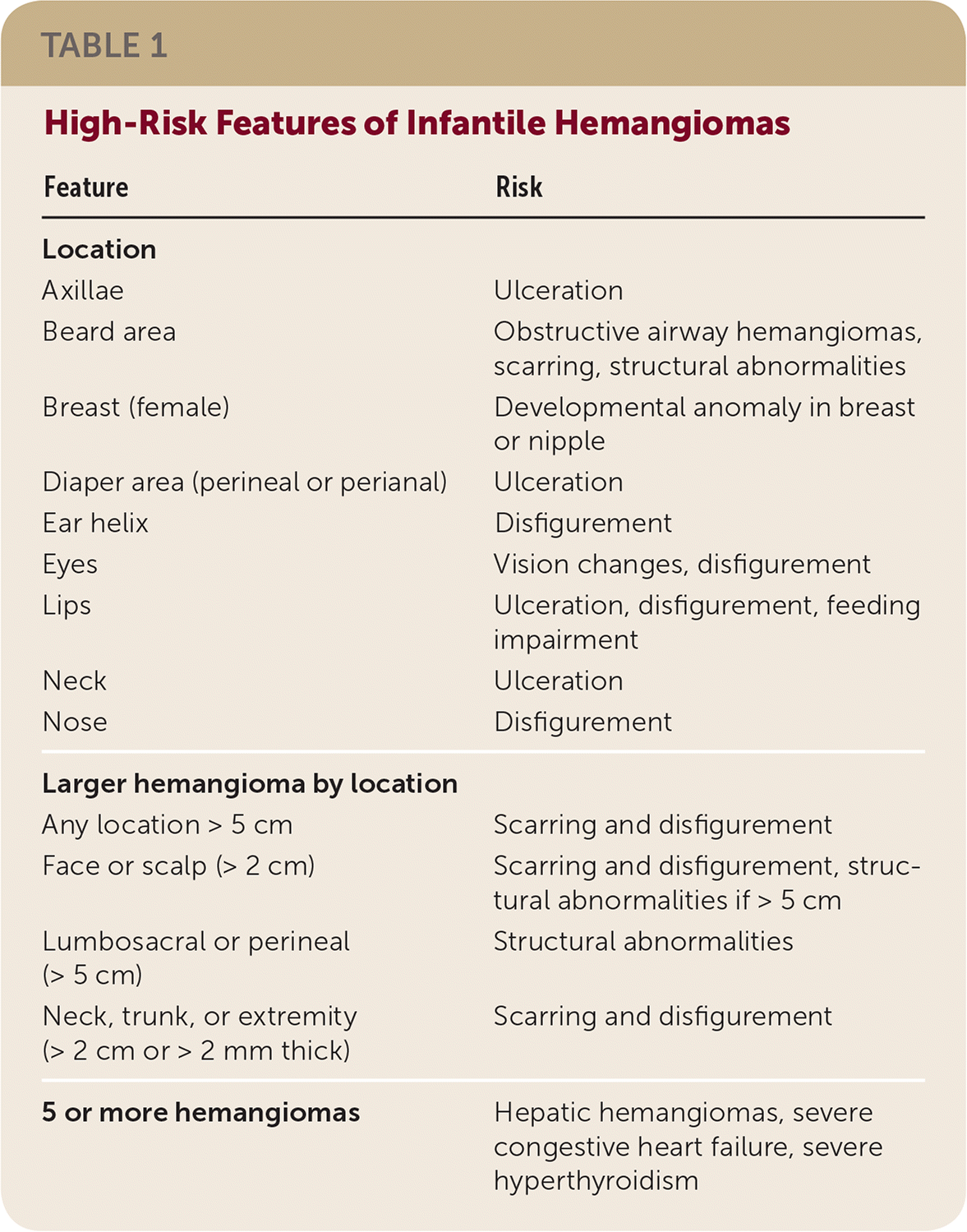
Am Fam Physician. 2019;100(3):186-187
Author disclosure: No relevant financial affiliations.
Key Points for Practice
• Although most infantile hemangiomas are self-limited, some are higher risk requiring immediate referral.
• Infants with hemangiomas need imaging only if there are signs of underlying structural abnormalities or diagnostic uncertainty.
• Oral propranolol is the first-line therapy for infantile hemangiomas.
From the AFP Editors
Infantile hemangiomas are the most common benign tumors of childhood, occurring in up to approximately 5% of infants. These benign vascular tumors are small, self-resolving, and do not require treatment. A minority of hemangiomas have been recently recognized to be at high risk of functional impairment or disfigurement and require prompt evaluation and treatment. The American Academy of Pediatrics (AAP) published this guideline to enhance the ability of primary care physicians to assess and manage infantile hemangiomas using evidence-based recommendations.
Clinical Presentation
Infantile hemangiomas grow rapidly between one and three months of age, and usually complete growing by five months. They are more common in girls, twins, infants born preterm or with low birth weight, and in white infants. Patients at the greatest risk of permanent skin changes are those with larger lesions, lesions elevated greater than 2 mm above the skin, and lesions that abruptly transition to normal skin.
High-risk infantile hemangiomas are characterized by location, size, and number. Hemangiomas near the eye may affect vision, and lesions near the eye, ear, and nose have high risk of disfigurement. There is an increased risk of ulceration for lesions on the lips, face, or neck area and they are at very high risk of scarring. Hemangiomas in the beard area are associated with airway hemangiomas and asphyxiation. Larger hemangiomas are associated with permanent skin changes (e.g., thickening, atrophy, scarring). Larger infantile hemangiomas on the face or in the lumbosacral area may also be associated with underlying structural anomalies. If the infant has five or more cutaneous hemangiomas at any site, it may indicate hepatic hemangioma, which is associated with high output congestive heart failure and severe hyperthyroidism. Table 1 lists characteristics of high-risk infant hemangiomas. Small lesions on the torso are lower risk and do not typically require treatment.

| Feature | Risk |
|---|---|
| Location | |
| Axillae | Ulceration |
| Beard area | Obstructive airway hemangiomas, scarring, structural abnormalities |
| Breast (female) | Developmental anomaly in breast or nipple |
| Diaper area (perineal or perianal) | Ulceration |
| Ear helix | Disfigurement |
| Eyes | Vision changes, disfigurement |
| Lips | Ulceration, disfigurement, feeding impairment |
| Neck | Ulceration |
| Nose | Disfigurement |
| Larger hemangioma by location | |
| Any location > 5 cm | Scarring and disfigurement |
| Face or scalp (> 2 cm) | Scarring and disfigurement, structural abnormalities if > 5 cm |
| Lumbosacral or perineal (> 5 cm) | Structural abnormalities |
| Neck, trunk, or extremity (> 2 cm or > 2 mm thick) | Scarring and disfigurement |
| 5 or more hemangiomas | Hepatic hemangiomas, severe congestive heart failure, severe hyperthyroidism |
Management
REFERRAL
Infantile hemangiomas that are classified as high-risk should be referred to a hemangioma subspecialist as soon as possible (strong recommendation, expert opinion). Parents or caregivers should be educated about the natural history of hemangiomas and the potential for causing complications or disfigurement (strong recommendation, expert opinion).
IMAGING
Imaging of lesions is not necessary unless the diagnosis is uncertain, there are five or more cutaneous lesions, or anatomic abnormalities are suspected (moderate recommendation, clinical trials with minor limitations). For an uncertain diagnosis, ultrasonography is recommended as the first imaging modality (weak recommendation, observational studies with inconsistent findings). Magnetic resonance imaging should be performed when structural abnormalities are suspected (moderate recommendation, clinical trials with minor limitations).
TREATMENT
Oral propranolol at 2 to 3 mg per kg daily is effective for the systemic treatment of infantile hemangiomas in the absence of structural abnormalities (strong recommendation, well-designed clinical trials and systematic review). Parents and caregivers should be told to administer propranolol with or after feeding and be educated about the adverse effects (e.g., sleep disturbance, bronchial irritation) of the medication.
The following secondary therapies are moderate recommendations based on clinical trials with minor limitations. Oral corticosteroids can be used as secondary therapy for contraindications or lack of response to propranolol. Intralesional injection of triamcinolone and/or betamethasone may be used to treat focal or bulky infantile hemangiomas. Topical timolol may also be prescribed for thin or superficial lesions. Surgical or laser treatment has some evidence for use. This treatment is most useful for residual skin changes after involution, and less commonly may be considered earlier to treat some infantile hemangiomas (moderate recommendation, observational studies with inconsistent findings).
Guideline source: American Academy of Pediatrics
Evidence rating system used? Yes
Systematic literature search described? Yes
Guideline developed by participants without relevant financial ties to industry? Yes
Recommendations based on patient-oriented outcomes? Yes
Published source: Pediatrics. January 2019;143(1):e20183475
